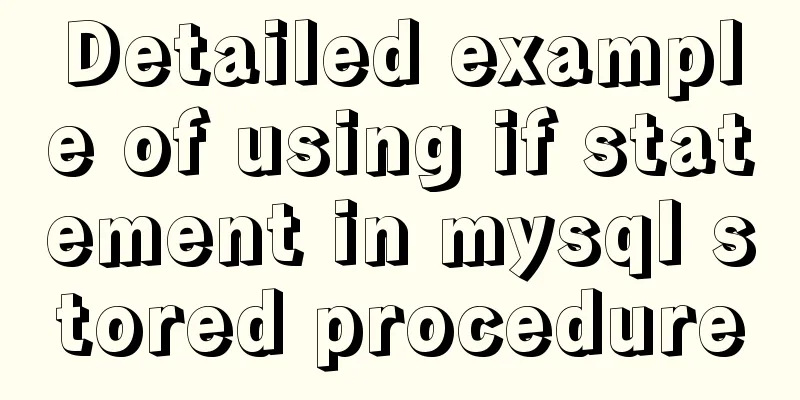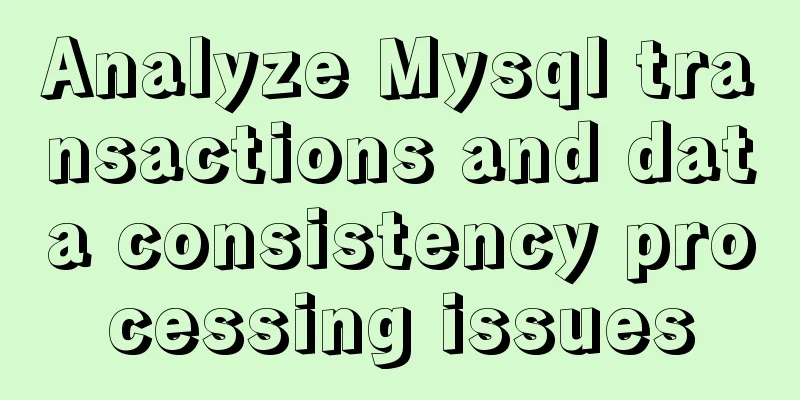Detailed example of using if statement in mysql stored procedure

|
This article uses an example to illustrate the usage of the if statement in MySQL stored procedure. Share with you for your reference, the details are as follows: The IF statement in MySQL allows us to execute a set of SQL statements based on a certain condition or value result of an expression, so we have to form an expression in MySQL, which can be combined with text, variables, operators, and even functions. An expression can return one of three values: TRUE, FALSE, or NULL. Let's look at the grammatical structure: IF expression THEN statements; END IF; If the above expression evaluates to TRUE, then the statements will be executed, otherwise the control flow will pass to the next statement after END IF. Let's take a look at the execution process of the IF statement:
Let's look at the syntax of the IF ELSE statement: IF expression THEN statements; ELSE else-statements; END IF; Now let's look at the execution process of the IF ELSE statement:
If we want to conditionally execute statements based on multiple expressions, we use the IF ELSE IF ELSE statement, and its syntax structure is as follows: IF expression THEN statements; ELSEIF elseif-expression THEN elseif-statements; ... ELSE else-statements; END IF; If expression evaluates to TRUE, the statements in the IF branch are executed; if expression evaluates to FALSE and elseif_expression evaluates to TRUE, mysql executes elseif-expression, otherwise it executes the else-statements in the ELSE branch. Let's take a look at the specific implementation process:
We then use the IF ESLEIF ELSE statement and the GetCustomerLevel() stored procedure to accept two parameters: customer number and customer level. First, the GetCustomerLevel() stored procedure must first obtain the credit limit from the customers table. Then, based on the credit limit, it determines the customer level: PLATINUM, GOLD, and SILVER. The parameter p_customerlevel stores the customer level and is used by the calling program. Let's look at the specific SQL:
DELIMITER $$
CREATE PROCEDURE GetCustomerLevel(
in p_customerNumber int(11),
out p_customerLevel varchar(10))
BEGIN
DECLARE creditlim double;
SELECT creditlimit INTO creditlimit
FROM customers
WHERE customerNumber = p_customerNumber;
IF creditlim > 50000 THEN
SET p_customerLevel = 'PLATINUM';
ELSEIF (creditlim <= 50000 AND creditlim >= 10000) THEN
SET p_customerLevel = 'GOLD';
ELSEIF creditlim < 10000 THEN
SET p_customerLevel = 'SILVER';
END IF;
END$$
The flow chart of the logic for determining customer level is as follows:
Okay, that’s all for this sharing. Readers who are interested in more MySQL-related content can check out the following topics on this site: "MySQL stored procedure skills", "MySQL common function summary", "MySQL log operation skills", "MySQL transaction operation skills summary" and "MySQL database lock related skills summary" I hope this article will be helpful to everyone's MySQL database design. You may also be interested in:
|
<<: jQuery realizes the picture following effect
>>: How to open ports to the outside world in Alibaba Cloud Centos7.X
Recommend
javascript to switch pictures by clicking a button
This article example shares the specific code of ...
An article teaches you how to use js to achieve the barrage effect
Table of contents Create a new html file: Create ...
Detailed explanation of PHP+nginx service 500 502 error troubleshooting ideas
Overview When a 500 or 502 error occurs during ac...
Detailed explanation of Mybatis special character processing
Preface: Mybatis special character processing, pr...
Solution to 1290 error when importing file data in mysql
Error scenario Use the mysql command in cmd to ad...
WeChat applet implements jigsaw puzzle game
This article shares the specific code for impleme...
JavaScript implements asynchronous submission of form data
This article example shares the specific code of ...
Solution to Mysql binlog log file being too large
Table of contents 1. Related binlog configuration...
MySQL column to row conversion, method of merging fields (must read)
Data Sheet: Column to row: using max(case when th...
CSS Houdini achieves dynamic wave effect
CSS Houdini is known as the most exciting innovat...
MySQL foreign key constraint (FOREIGN KEY) case explanation
MySQL foreign key constraint (FOREIGN KEY) is a s...
HTML allows partial forced scroll bars to not destroy the overall style and layout
First post the effect picture: A scroll bar appear...
Completely delete MySQL steps
Table of contents 1. Stop MySQL Server first 2. U...
JavaScript mobile H5 image generation solution explanation
Now there are many WeChat public account operatio...
Summary of the differences and usage of plugins and components in Vue
The operating environment of this tutorial: Windo...













